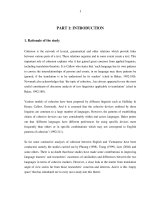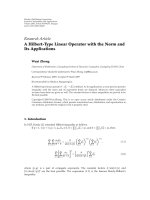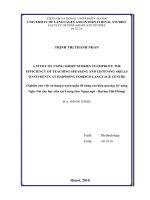A study on connotative equivalence between Gone with the wind and its translation in Vietnamese by Duong Tuong
Bạn đang xem bản rút gọn của tài liệu. Xem và tải ngay bản đầy đủ của tài liệu tại đây (87.44 KB, 3 trang )
A study on connotative equivalence between
"Gone with the wind" and its translation in
Vietnamese by Duong Tuong
Nguyễn Thị Diệu Thúy
Trường Đại học Ngoại ngữ
Luận văn Thạc sĩ ngành: English Linguistics; Mã số: 60 22 15
Người hướng dẫn: Assoc. Prof. Dr. Lê Hùng Tiến
Năm bảo vệ: 2012
Abstract. The researcher conducted a study to investigate the kinds of connotative
equivalence between the novel "Gone with the wind" and its translated version by
Duong Tuong. Different kinds of connotative equivalence have been identified.
Technical data from both the source text and target text was collected. Then the data
was examined carefully to assess the degree of connotative equivalence achieved. The
following five kinds of connotative equivalence are the most typical and well achieved
in the source text: connotations of speech level (elevated, normal, poetic, and
colloquial), connotations of socially determined usage (the language of the upper class
and the slaves), connotations of geographical origin (comparative structures),
connotations of register (military and religious), and connotations of evaluation
(pejorative, positive and ironic). All in all, it can be concluded that connotative
equivalence is achieved between the novel and the translation by Duong Tuong.
Keywords. Ngôn ngữ học; Tiếng Anh; Dịch thuật
Content
I. Statement of the problem and rationale for the study
Over the past few decades, international exchange is processing vigorously in various
aspects, especially in culture. By using language to bridge the gap between different cultures,
inevitably, translation has contributed significantly to this process. Besides, literature has been
chosen as a rich source for translation. Literary works are not only written in different languages
but they also feature different cultures and civilizations. Accordingly, the literary translation
process is quite complex as it requires the translator to consider every aspect of the material, or
even beyond the material in order to produce a good translation. It poses a great challenge for
anyone who attempts to assess the quality of translated literary works.
According to Chesterman (1989) “Equivalence is obviously a central concept in
translation theory”. “The notion of equivalence held sway as a key issue in translation
throughout the 1970s and beyond.” (Munday, 2008, p. 49). Various works on translation theories
have been carried out just to show how vital equivalence is in translation. Great importance has
been attached to equivalence since this is a controversial issue and it is likely to cause debates in
the coming time. However, despite its significance, little investigation has been carried out in the
field of translation evaluation, particularly evaluation of equivalence between English and
Vietnamese literary works.
All the above made the researcher decide to carry out the study on equivalence in literary
translation. Specifically, the study investigates connotation equivalence achieved in the
translation of “Gone with the wind” – one of the most famous novels of the 20
th
century. This
novel has been chosen as the source language text due to its distinctive features, aesthetic values
and popularity worldwide. The novel was first translated into Vietnamese more than 20 years
ago. Among several versions of the translation, the one translated by Duong Tuong is most
praised by readers. With the aim of investigating one of Duong Tuong's best translated works,
the researcher chose his translation as the target text.
II. Research aims and research questions
The study firstly aims at providing a theoretical background on some issues relevant to
the topic of the study, which are translation, literary translation, equivalence in translation and
strategies to achieve equivalence.
Secondly, the study is to investigate the types of connotative equivalence achieved
between the novel and its translated version.
Thirdly, the study is also aimed at finding out what strategies adopted by the translator in
order to achieve that equivalence.
Addressing the above issues is hoped to help English learners, especially those specialize
in translation enhance their awareness of various expressive means employed in a particular
literary text and decide the most appropriate strategies to deal with different translation
situations.
The study is also expected to be a good reference of criteria to any Vietnamese readers
who love romantic novel, and are fans “Gone with the wind” for a good translation.
These aims can be formulated into the following research questions.
1. What types of connotative equivalence achieved between the novel "Gone with the wind"
and its translation by Duong Tuong?
2. What strategies adopted by the translator to achieve such types of connotative
equivalence?
III. Scope of the study
Firstly, the theoretical background of the study only focuses on some fundamental issues
in translation theory which are of vital importance to the issue examined, which are translation,
equivalence, methods, and procedures.
Secondly, the research focuses on one kind of equivalence, which is connotative
equivalence. Then only the most outstanding types of connotative equivalence are examined.
IV. Methods of the study
1. Data collection
The study is designed in accordance with the theory proposed by Koller (1979), that is
characterizes the connotative dimensions of a source language (with the support of stylistic
studies) to analyse their features and structural elements, and then relate these to the connotative
dimenstions of a given target language. In the first stage, the study explores the source language
text to find out the different dimensions of connotations. The features and structural elements of
each connotative dimension are defined. Data are collected in both English and Vietnamese to
illustrate these dimensions. Even though the novel is almost six hundred pages long, the
researcher tries to collect comprehensive data by investigating almost every chapter.
Subsequently, the examples are grouped according to the stated catergory for the sake of
comparison and assessment.
2. Data analysis
In the second stage of the study, an assessment of the features in the target language text is
carried out with the criteria established in the first stage. The translation and the data are
considered from various viewpoints. The study is based on technical data of semantic densities,
occurrence probabilities and repetition rates of both the source language and target language text
to evaluate the degree of connotative equivalence achieved. As stated by Koller (1979),
equivalence is defined in terms of the frame and conditions that the target text must fulfill if
there exists equivalence between a given source text and a given target text. The conditions can
be content, style, function, etc. Therefore, the requirement of equivalence has the following
form: quality (qualities) X in the source language text must be preserved, meaning the source
language content, form, style, function, etc must be preserved or at least the translation must seek
to preserve them as far as possible (Koller, 1979). Besides, the connotations are transmitted by
means of the word choice. Thus, the word choices that can affect the content, form, style or
function of translation are investigated carefully. After that, conclusions on types of connotative
equivalence achieved are drawn. Furthermore, based on the translation of Duong Tuong, the
researcher also figures out the strategies employed to achieve connotative equivalence. The
strategies are categorized according to Newmark's theory about translation methods and
translation procedures.
References
1. Baker, M. (1992). In Other Words. USA & Canada: Routledge.
2. Baker, M., & Saldanha, G (Eds). (2009). Routledge Encyclopedia of Translation Studies (2
nd
ed). USA & Canada: Routledge.
3. Bassnett, S. (2002). Translation Studies (3
rd
ed). USA & Canada: Routledge.
4. Catford, J, C. (1965). A Linguistic Theory of Translation: an Essay on Applied
Linguistics. London: Oxford University Press.
5. Chesterman, A. (1989). Readings in Translation Theory. Findland: Loimaan Kirjapaino Oy.
6. Fast, P., & Osadnik, W.M (Eds). (1998). Studies in comparative literature and translation
(Vol 1). Edmonton: University of Alberta
7. Hatim, B., & Munday, J. (2004). Translation An Advanced Resource Book. USA, Canada:
Routledge
8. Hartman, R.R.K., & Stork, R.C. (1972). Dictionary of Language and Linguistic. In Bell, R.T,
Translation and Translating: Theory and Practice. London & New York: Longman
9. Jakobson, R. (2004). On Linguistic aspect of translation. In Venuti, L (Ed), The Translation
Studies Reader (pp. 138 – 143). London: Routledge
10. Koller, W. (1979). Equivalence in translation theory. In Chesterman, A (Ed), Readings in
Translation Theory (pp. 186 – 191). Findland: Loimaan Kirjapaino Oy.
11. Landers, C.E. (2001). Literary Translation. Great Britain: Cromwell Press Ltd.
12. Munday, J. (2008). Introducing Translation Studies (2
nd
ed). USA, Canada: Routledge.
13. Newmark, P. (1988). Approaches to Translation. UK: Prentice Hall International Ltd.
14. Newmark, P. (1988). A Textbook of Translation. UK: Prentice Hall International Ltd.
15. Nida, E. A. (1964). Toward a Science of Translating. Leiden: E.J. Brill
16. Nida, E. A., & Taber, C. R. (1982). The Theory and Practice of Translation (2
nd
ed).
Leiden: E.J. Brill
17. Pym, A. (2010). Exploring Translation Theories. USA & Canada: Routledge.
18. Snell – Hornby, M. (1988). Translation Studies: An Integrated Approach. Amsterdam and
Philadelphia: J. Benjamins Pub. Co.
19. Shuttleworth, M. , & Cowie, M. (1997). Dictionary of Translation Studies. Manchester: St
Jerome
20. Fawcett, P. (1997). Translation and Language Linguistic Theories Explained. Manchester:
St Jerome.









